#Seville Records
Explore tagged Tumblr posts
Audio

Snoopy Dean - Shake n' Bump (Seville)
prod. Willie Calrke & Steve Alaimo, 1974.
#Snoopy Dean#Shake n' Bump#pt1.#seville records#1974#tk productions#willie clarke#steve alaimo#florida#funk
2 notes
·
View notes
Text










On the Christmas 🎄 Turntable today...
That Christmas Feeling (1973)
KBEZ 93FM: Christmas Festival Of Music (1981)
Firestone Tires Presents Your Favorite Christmas Music Volume 4 (1965)
Christmas With The Chipmunks (1962)
#thatchristmasfeeling #jcpenney #kbez #kbez93fm #tulsa #oklahoma #tulsaoklahoma #christmasfestivalofmusic #kbez93fmchristmasfestivalofmusic #medx #cocacola #Firestone #firestonetires #firestonepresentsyoufavoritechristmasmusicvolme4 #thechipmunks #christmaswiththechipmunks #alvinsimonandtheodore #DavidSeville #60s #70s #80s #records #album #LP #vinyl #vinylrecords #Christmas #merrychristmas2024 #merrychristmas
#That Christmas Feeling#jc penney#KBEZ 93FM#KBEZ#tulsa#oklahoma#tulsa oklahoma#christmas festival of music#kbez 93fm christmas festival of music#med-x#coca cola#Firestone Tires#Firestone#firestone presents your favorite christmas music volume 4#the chipmunks#christmas with the chipmunks#alvin simon & theodore#david seville#60s#70s#80s#records#album#lp#vinyl records#vinyl#christmas#merry christmas 2024#merry christmas#Spotify
12 notes
·
View notes
Text
























New photos | Shakira and Bizarrap react after receiving their Record of the Year award during the 24th Annual Latin Grammy Awards in Seville, Spain. (Nov 16, 2023)
#shakira#shakira mebarak#bizarrap#celebs#celebrities#latin grammys 2023#latin grammys#grammys#record of the year#bzrp music sessions vol. 53#seville#spain#new photos#photos#november 2023
15 notes
·
View notes
Text










Hermosa 🖤
#anitta#latin recording academy#person of the year#seville#gorgeous#woman#black outfit#silver bag#red hair#make-up#goals#brazilian#singer
8 notes
·
View notes
Text
Anyone who's been collecting Alvin and the Chipmunk memorabilia for an extended amount of time will know how hard it is to find this 45. The first 45, with the sleeve in the green backed first run.
Well. I did it. Randomly on eBay. And I'm so excited to have it.


I didn't realize the original sleeve wasn't cardboard. It was paper. No wonder it's so hard to find it with the sleeve!
#alvin and the chipmunks#alvin seville#the chipmunks#1958#the chipmunk song#alvins harmonica#david seville#liberty records
2 notes
·
View notes
Text

“There’s never been a more perfect fabric for me.”
4 notes
·
View notes
Text

'Commemorative' image of the original Alvin & the Chipmunks (circa 1958, but more on that later) meeting the 'new' Alvin & the Chipmunks (circa 1983).
This whole thing reminds me of the two Jennifers' "I'm old! / I'm young!" bit from Back to the Future II. Try not to look so freaked out, 1980's Chipmunks.
So, although the CD from which this image was taken was released in 1993 (making the count of 35 years correct), the 'old' David Seville, Alvin, Simon and Theodore as shown are from the 1961 TV cartoon show, while the 'new' gang are based on the 1983/88/89 TV cartoon show designs. Still, it's a cute gag.
I also feel obligated to mention that A&TC (and/or the Chippettes) have released versions of "Beat It," "Uptown Girl," "Girls Just Wanna Have Fun," and "Leader of the Pack."
#alvin and the chipmunks#david seville#alvin#simon#theodore#1983#1961#1993#cartoons#music#novelty songs#novelty records#tv#retro#nostalgia#1980's#1960's#1980s#1960s#80's#60's#80s#60s
6 notes
·
View notes
Text
“Got in a 2 mile run on the treadmill today.”
“I was going to record voices for a fan project for a friend, but unfortunately the computer just won’t read my mic anymore since the last update. Simon said he’d look at it when he gets a chance.”
“So now I basically don’t know what to do today.”
#eleanor miller#alvin and the chipmunks#alvinnn and the chipmunks#aatc#simon seville#record#voices#mic#treadmill#GOSH I HATE COMPUTER UPDATES SO MUCH#what am i supposed to do#annoyed#irritated
1 note
·
View note
Text
Ummm do you guys know how they got the audio from Justin Long and them for the chipmunk movie..? It's uh...a little unsettling hearing it like this
youtube
#alvin and the chipmunks#alvin seville#theodore seville#simon seville#the chipmunks#recording#behind the scenes#the making of#Youtube
1 note
·
View note
Text
Anna Haining Swan et Martin Van Buren Bates - le plus grand couple du monde
Nouvel article publié sur https://www.2tout2rien.fr/anna-haining-swan-et-martin-van-buren-bates-le-plus-grand-couple-du-monde/
Anna Haining Swan et Martin Van Buren Bates - le plus grand couple du monde
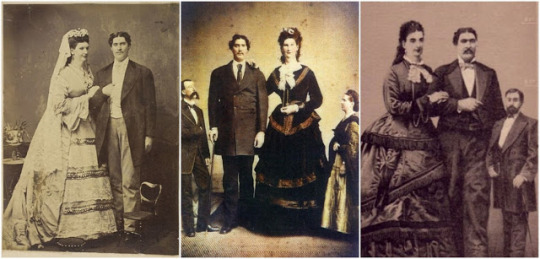
#19eme siecle#Anna Haining Swan#années 1870#années 1880#Couple#géant#grand#guerre#guiness book#Kentucky#londres#mariage#Martin Van Buren Bates#ohio#record du monde#secession#Seville#taille#trafalgar#USA#vintage#imxok#people
1 note
·
View note
Text
Gotye featuring Kimbra - Somebody That I Used to Know 2011
"Somebody That I Used to Know" is a song written, produced and performed by Australian musician and singer Gotye, featuring vocals from New Zealand singer Kimbra. The song samples Luiz Bonfá's 1967 instrumental song "Seville", with additional instrumentations of beats and a xylophone playing a melody based on "Baa, Baa, Black Sheep". The song was released in Australia and New Zealand on 5 July 2011 as the second single from Gotye's third studio album, Making Mirrors (2011). It was released in December 2011 in the UK, and 20 January 2012 in Ireland and the US.
In Australia, the song won the Triple J Hottest 100 poll at the end of 2011, as well as ARIA Music Awards for Song of the Year and Best Video, while Kimbra was voted Best Female Artist, and Gotye was named Best Male Artist and Producer of the Year. The song came ninth in the Triple J Hottest 100 of the Past 20 Years, 2013. At the 55th Annual Grammy Awards, "Somebody That I Used to Know" won two Grammys for Best Pop Duo/Group Performance and Record of the Year.
Commercially, "Somebody That I Used to Know" was a global success and became both artists' signature song. It reached the top of the charts in Australia, New Zealand, the UK and the US, as well as 25 other official charts, and reached the Top 10 in more than 30 countries. Globally, "Somebody That I Used to Know" has sold more than 20 million copies, becoming one of the best-selling digital singles of all time. Gotye paid tribute to the overwhelming number of cover versions of the song by personally creating a video remix, released in August 2012, using segments from hundreds of online covers to create a new, unique version of the track, titled "Somebodies: A YouTube Orchestra".
"Somebody That I Used to Know" received a total of 87,6% yes votes!
youtube
#finished#high votes#high yes#high reblog#10s#gotye#kimbra#english#o1#o1 sweep#o1 ultrasweep#lo24#lo24 tie#lo2#lo4#popular
2K notes
·
View notes
Text

"Women could be found working on construction sites, if only occasionally, including in specialized roles such as carpenters and masons. The research is found in the article, “Appropriate to Her Sex?” Women’s Participation on the Construction Site in Medieval and Early Modern Europe,” by Shelley E. Roff.
She surveyed a wide variety of records from throughout Western Europe, including tax records, inventories of wages paid on construction sites, and municipal accounts, and discovered numerous instances of women working alongside men on construction sites as far back at the 13th century. Most of these women were employed as day laborers, carrying out tasks such as moving water and building supplies around the sites, digging ditches and serving as assistants to bricklayers and stonemasons. For example, in the Spanish city of Seville during the 14th century, women were hired to dig trenches for the foundation of a new city wall, while at the nearby city of Toledo, one or two women were hired each day for the construction of the city’s cathedral, where they gathered lime and worked on the roof. Meanwhile in the French city of Toulouse, almost half the laborers working on the Perigord college site were women. Ross also finds several examples from England and Germany.
Roff notes that previous historians have seen many examples of women working on construction sites in their research, but they had believed that these were just abnormal exceptions caused by economic crises, or because the male population had been killed off through war or disease. But her new study suggests that women construction workers were more than just odd occurences. She explains that “the expansion of urban centers starting in the thirteenth century set off a trend of increasing female employment for day laborers and in the crafts, which only began to contract on occasion for women working in the crafts in the sixteenth century with ensuing economic crises.”
She also notes that in almost all accounts surveyed, the women were paid at a lower rate than the men, which would make the “a cost-effective solution” for site supervisors looking for ways to reduce expenses. The women who took these jobs would have come from society’s poor – those women who could not maintain their households and families just from their husbands’ (if they had one) income.
Roff also finds records showing women taking part in specialized building trades. In London in 1383, Katherine Lightfoot is recorded as the supplier of 2,000 painted tiles for bath in the King’s palace. Meanwhile, tax records from Paris during the years 1296 and 1313 reveal the existence of two female masons, a tiler and a plasterer. These women were not poorer individuals, rather they were the wives of male craftsman, and in some cases their widows. The 15th-century French writer Christine de Pizan noted in her book The Treasury of the City of Ladies that craftswomen, “should learn all the shop details so that she can properly supervise the workers when her husband is away or not paying attention.”
Women workers could be found on the medieval construction site, Medievalists.net
#history#women in history#women's history#working women#historyedit#middle ages#medieval women#medieval history#european history#french history#spanish history#historical#historyblr
800 notes
·
View notes
Text
HERE THEY ARE!!! Enjoy! Alvin wanted to do 2 of them. He's so extra.
This is a note reminding me to post the latest random audio I have recorded.
I let each Chipmunk and Chipette talk for 3 minutes unscripted and the results are FASCINATING!
They’re so fun to listen back to. Every character is so unapologetically themself.
#alvin and the chipmunks#voice acting#recording#randomness#improv#talking#characters#this was so fun#alvin seville#brittany miller#theodore seville#simon seville#eleanor miller#jeanette miller#alvinnn and the chipmunks#alternate universe#rambling#unscripted
11 notes
·
View notes
Text
Did the ancient Celts really paint themselves blue?
Part 2: Irish tattoos



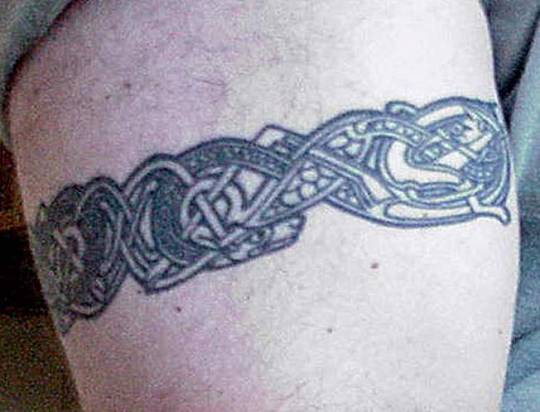
Clockwise from top left: Deirdre and Naoise from the Ulster Cycle by amylouioc, detail from The Marriage of Strongbow and Aoife by Daniel Maclise, a modern Celtic revival tattoo, Michael Flatley in a promotional image for the Irish step dance show 'Lord of the Dance'
This is my second post exploring the historical evidence for our modern belief that the ancient and medieval Insular Celts painted or tattooed themselves with blue pigment. In the first post, I discussed the fact that body paint seems to have been used by residents of Great Britain between approximately 50 BCE to 100 CE. In this post, I will examine the evidence for tattooing.
Once again, I am looking at sources pertaining to any ethnic group who lived in the British Isles, this time from the Roman Era to the early Middle Ages. The relevant text sources range from approximately 200 CE to 900 CE. I am including all British Isles cultures, because a) determining exactly which Insular culture various writers mean by terms like ‘Briton’, ‘Scot’, and ‘Pict’ is sometimes impossible and b) I don’t want to risk excluding any relevant evidence.
Continental Written Sources:
The earliest written source to mention tattoos in the British Isles is Herodian of Antioch’s History of the Roman Empire written circa 208 CE. In it, Herodian says of the Britons, "They tattoo their bodies with colored designs and drawings of all kinds of animals; for this reason they do not wear clothes, which would conceal the decorations on their bodies" (translation from MacQuarrie 1997). Herodian is probably reporting second-hand information given to him by soldiers who fought under Septimius Severus in Britain (MacQuarrie 1997) and shouldn't be considered a true primary source.
Also in the early 3rd century, Gaius Julius Solinus says in Collectanea Rerum Memorabilium 22.12, "regionem [Brittaniae] partim tenent barbari, quibus per artifices plagarum figuras iam inde a pueris variae animalium effigies incorporantur, inscriptisque visceribus hominis incremento pigmenti notae crescunt: nec quicquam mage patientiae loco nationes ferae ducunt, quam ut per memores cicatrices plurimum fuci artus bibant."
Translation: "The area [of Britain] is partly occupied by barbarians on whose bodies, from their childhood upwards, various forms of living creatures are represented by means of cunningly wrought marks: and when the flesh of the person has been deeply branded, then the marks of the pigment get larger as the man grows, and the barbaric nations regard it as the highest pitch of endurance to allow their limbs to drink in as much of the dye as possible through the scars which record this" (from MacQuarrie 1997).
This passage, like Herodian's, is clearly a description of tattooing, not body staining or painting. That said, I have no idea of tattoos actually work like this. I would think this would result in the adult having a faded, indistinct tattoo, but if anyone knows otherwise, please tell me.
The poet Claudian, writing in the early 5th c., is the first to specifically mention the Picts having tattoos (MacQuarrie 1997). In De Bello Gothico he says, "Venit & extremis legio praetenta Britannis,/ Quæ Scoto dat frena truci, ferroque notatas/ Perlegit exanimes Picto moriente figuras."
Translation: "The legion comes to make a trial of the most remote parts of Britain where it subdues the wild Scot and gazes on the iron-wrought figures on the face of the dying Pict" (from MacQuarrie 1997).
Last, and possibly least, of our Mediterranean sources is Isidore of Seville. In the early 7th c. he writes, "the Pictish race, their name derived from their body, which the efficient needle, with minute punctures, rubs in the juices squeezed from native plants so that it may bring these scars to its own fashion [. . .] The Scotti have their name from their own language by reason of [their] painted body, because they are marked by iron needles with dark coloring in the form of a marking of varying shapes." (translation from MacQuarrie 1997)
Isidore is the earliest writer to explicitly link the name 'Pict' to their 'painted' (Latin: pictus) i.e. tattooed bodies. Isidore probably borrowed information for his description from earlier writers like Claudian (MacQuarrie 1997).
In the 8th century, we have a source that definitely isn't Romans recycling old hearsay. In 786, a pair of papal legates visited the Anglo-Saxon kingdoms of Mercia and Northumbria (Story 1995). In their report to Pope Hadrian, the legates condemn pagans who have "superimposed most hideous cicatrices" (i.e gotten tattoos), likening the pagan practice to coloring oneself "with dirty spots". The location of the visit indicates that these are Anglo-Saxon tattoos rather than Celtic, but some scholars have suggested that the Anglo-Saxons might have adopted the practice from the Brittonic Celts (MacQuarrie 1997).
A gloss in the margin of the late 9th c. German manuscript Fulda Aa 2 defines Stingmata [sic] as "put pictures on the bodies as the Irish (Scotti) do." (translation from MacQuarrie 1997).
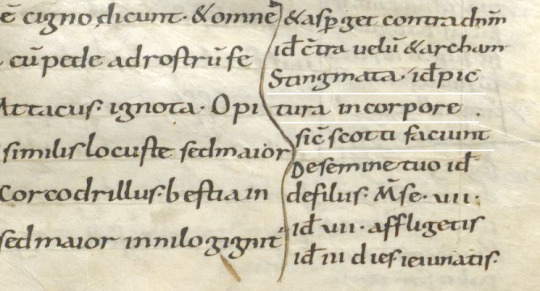
Fulda Aa 2 folio 43r The gloss is on the left underlined in white.
Irish Written Sources:
Irish texts that mention tattoos date to approximately 700-900 CE, although some of them have glosses that may be slightly later, and some of them cannot be precisely dated.
The first text source is a poem known in English as "The Caldron of Poesy," written in the early 8th c. (Breatnach 1981). The poem is purportedly the work of Amairgen, ollamh of the legendary Milesian kings. In the first stanza of the poem, he introduces himself saying, "I being white-kneed, blue-shanked, grey-bearded Amairgen." (translation from Breatnach 1981)
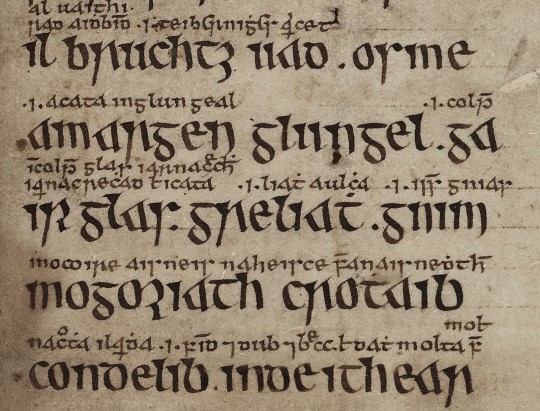
The text of the poem with interline glosses from Trinity College Dublin MS 1337/1
The word garrglas (blue-shanked) has a Middle Irish (c. 900-1200) gloss added by a later scribe, defining garrglas as: "a tattooed shank, or who has the blue tattooed shank" (Breatnach 1981).
Although Amairgen was a mythical figure, the position ollamh was not. An ollamh was the highest rank of poet in medieval Ireland, considered worthy of the same honor-price as a king (Carey 1997, Breatnach 1981). The fact that a man of such esteemed status introduces himself with the descriptor 'blue-shanked' suggests that tattoos were a respectable thing to have in early medieval Ireland.
The leg tattoos are also mentioned c. 900 CE in Cormac’s Glossary. It defines feirenn as "a thong which is about the calf of a man whence ‘a tattooed thong is tattooed about [the] calf’" (translation from MacQuarrie 1997)
The Irish legal text Uraicecht Becc, dated to the 9th or early 10th c., includes the word creccoire on a list of low-status occupations (Szacillo 2012, MacNeill 1924). A gloss defines it as: crechad glass ar na roscaib, a phrase which Szacillo interprets as meaning "making grey-blue sore (tattooing) on the eyes" (2012). This sounds rather strange, but another early Irish text clarifies it.
The Vita sancti Colmani abbatis de Land Elo written around the 8th-9th centuries (Szacillo 2012) contains the following episode:
On another time, St Colmán, looking upon his brother, who was the son of Beugne, saw that the lids of his eyes had been secretly painted with the hyacinth colour, as it was in the custom; and it was a great offence at St Colmán’s. He said to his brother: ‘May your eyes not see the light in your life (any more). And from that hour he was blind, seeing nothing until (his) death. (translation from Szacillo 2012).
The original Latin phrase describing what so offended St Colmán "palpebre oculorum illius latenter iacinto colore" does not contain the verb paint (pingo). It just says his eyelids were hyacinth (blue) colored. This passage together with the gloss from the Uraicecht Becc implies that there was a custom of tattooing people's eyelids blue in early medieval Ireland. A creccoire* was therefore a professional eyelid tattooer or a tattoo artist.
A possible third reference to tattooing the area around the eye is found in a list of Old Irish kennings. The kenning for the letter 'B' translates as 'Beauty of the eyebrow.' This kenning is glossed with the word crecad/creccad (McManus 1988). Crecad could be translated as cauterizing, branding, or tattooing (eDIL). McManus suggests "adornment (by tattooing) of the eyebrow" as a plausible interpretation of how crecad relates to the beauty of the eyebrow (1988). The precise date of this text is not known (McManus 1988), but Old Irish was used c. 600-900 CE, meaning this text is of a similar date to the other Irish references to tattoos.
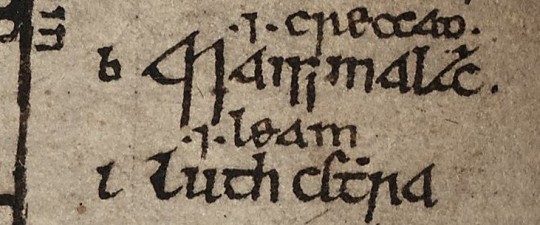
Kenning of the letter 'b' with gloss from TCD MS 1337/1
There is a sharp contrast between the association of tattoos with a venerated figure in 'The Caldron of Poesy', and their association with low-status work and divine punishment in the Uraicecht Becc and the Vita. This indicates that there was a shift in the cultural attitude towards tattoos in Ireland during the 7th-9th centuries. The fact that a Christian saint considered getting tattoos a big enough offense to punish his own brother with blindness suggests that tattooing might have been a pagan practice which gradually got pushed out by the Catholic Church. This timeline is consistent with the 786 CE report of the papal legates condemning the pagan practice of tattooing in Great Britain (MacQuarrie 1997).
There are some mentions of tattooing in Lebor Gabála Érenn, but the information largely appears to be borrowed from Isidore of Seville (MacQuarrie 1997). The fact that the writers of LGE just regurgitated Isidore's meager descriptions of Pictish and Scottish (ie Irish) tattooing without adding any details, such as the designs used or which parts of the body were tattooed, makes me think that Insular tattooing practices had passed out of living memory by the time the book was written in the 11th century.
*There is some etymological controversy over this term. Some have suggested that the Old Irish word for eyelid-tattooer should actually be crechaire. more info Even if this hypothesis is correct, and the scribe who wrote the gloss on creccoire mistook it for crechaire, this doesn't contradict my argument. The scribe clearly believed that eyelid-tattooer belonged on a list of low-status occupations.
Discussion:
Like Julius Cesar in the last post, Herodian of Antioch c. 208 CE makes some dubious claims of Celtic barbarism, stating that the Britons were: "Strangers to clothing, the Britons wear ornaments of iron at their waists and throats; considering iron a symbol of wealth, they value this metal as other barbarians value gold" (translation from MacQuarrie 1997). If the Britons wore nothing but iron jewelry, then why did they have brass torcs and 5,000 objects that look like they're meant to attach to fabric, Herodian?
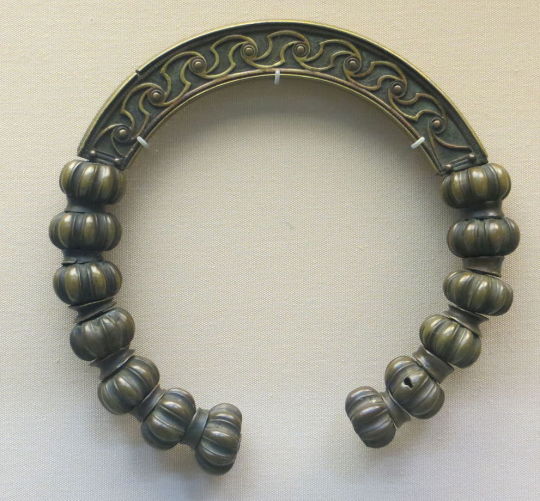
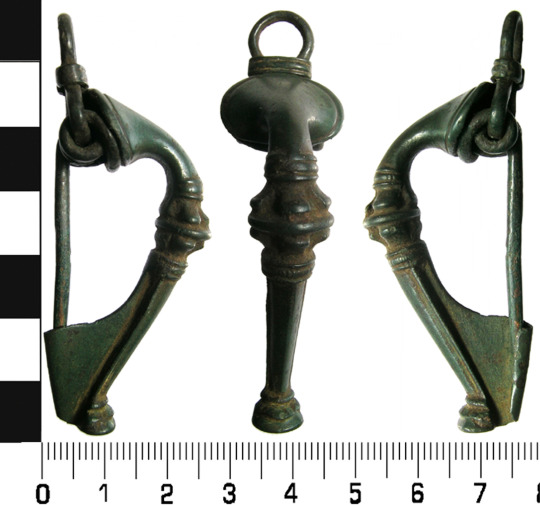
Brass torc from Lochar Moss, Scotland c. 50-200 CE. Romano-British trumpet brooch from Cumbria c. 75-175 CE. image from the Portable Antiquities Scheme.
Trumpet brooches are a Roman Era artifact invented in Britain, that were probably pinned to people's clothing. more info
Although Herodian and Solinus both make dubious claims, there are enough differences between them to indicate that they had 2 separate sources of information, and one was not just parroting the other. This combined with the fact that we have more-reliable sources from later centuries confirming the existence of tattoos in the British Isles makes it probable that there was at least a grain of truth to their claims of tattooing.
There is a common belief that the name Pict originated from the Latin pictus (painted), because the Picts had 'painted' or tattooed bodies. The Romans first used the name Pict to refer to inhabitants of Britain in 297 CE (Ware 2021), but the first mention of Pictish tattoos came in 402 CE (Carr 2005), and the first explicit statement that the name Pict was derived from the Picts' tattooed bodies came from Isidore of Seville c. 600 CE (MacQuarrie 1997). Unless someone can find an earlier source for this alleged etymology than Isidore, I am extremely skeptical of it.
Summary of the written evidence:
Some time between c. 79 CE (Pliny the Elder) and c. 208 CE (Herodian of Antioch) the practice of body art in Great Britain changed from staining or painting the skin to tattooing. Third century Celtic Briton tattoo designs depicted animals. Pictish tattoos are first mentioned in the 5th century.
The earliest mention of Irish tattoos comes from Isidore of Seville in the early 6th c., but since it seems to have been a pre-Christian practice, it likely started earlier. Irish tattoos of the 8-9th centuries were placed on the area around the eye and on the legs. They were a bluish color. The 8th c. Anglo-Saxons also had tattoos.
Tattooing in Ireland probably ended by the early 10th c., possibly because of Christian condemnation. Exactly when tattooing ended in Great Britain is unclear, but in the 12th c., William of Malmesbury describes it as a thing of the past (MacQuarrie 1997). None of these sources give much detail as to what the tattoos looked like.
The Archaeology of Insular Ink:
In spite of the fact that tattooing was a longer-lasting, more wide-spread practice in the British Isles than body painting, there is less archaeological evidence for it. This may be because the common tools used for tattooing, needles or blades for puncturing the skin, pigments to make the ink, and dishes to hold the ink, all had other common uses in the Middle Ages that could make an archaeologist overlook their use in tattooing. The same needle that was used to sew a tunic could also have been used to tattoo a leg (Carr 2005). A group of small, toothed bronze plates from a Romano-British site at Chalton, Hampshire might have been tattoo chisels (Carr 2005) or they might have been used to make stitching holes in leather (Cunliffe 1977).
Although the pigment used to make tattoos may be difficult to identify at archaeological sites, other lines of evidence might give us an idea of what it was. Although the written sources tell us that Irish tattoos were blue, the popular modern belief that woad was the source of the tattoo pigment is, in my opinion, extremely unlikely for a couple of reasons:
1) Blue pigment from woad doesn't seem to work as tattoo ink. The modern tattoo artists who have tried to use it have found that it burns out of the person's skin, leaving a scar with no trace of blue in it (Lambert 2004).
2) None of the historical sources actually mention tattooing with woad. Julius Cesar and Pliny the Elder mention something that might have been woad, but they were talking about body paint, not tattoos. (see previous post) Isidore of Seville claimed that the Picts were tattooing themselves with "juices squeezed from native plants", but even assuming that Isidore is a reliable source, you can't get blue from woad by just squeezing the juice out of it. In order to get blue out of woad, you have to first steep the leaves, then discard the leaves and add a base like ammonia to the vat (Carr 2005). The resulting dye vat is not something any knowledgeable person would describe as plant juice, so either Isidore had no idea what he was talking about, or he is talking about something other than blue pigment from woad.
In my opinion, the most likely pigment for early Irish and British tattoos is charcoal. Early tattoos found on mummies from Europe and Siberia all contain charcoal and no other colored pigment. These tattoos range in date from c. 3300 BCE (Ötzi the Iceman) to c. 300 CE (Oglakhty grave 4) (Samadelli et al 2015, Pankova 2013).
Despite the fact that charcoal is black, it tends to look blueish when used in tattoos (Pankova 2013). Even modern black ink tattoos that use carbon black pigment (which is effectively a purer form of charcoal) tend to look increasingly blue as they age.
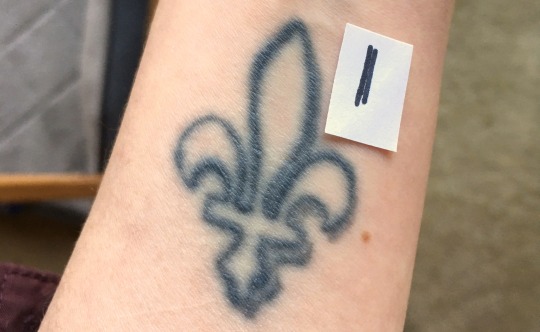
A 17-year-old tattoo in carbon black ink photographed with a swatch of black Sharpie on white printer paper.
The fact that charcoal-based tattoo inks continue to be used today, more than 5,000 years after the first charcoal tattoo was given, shows that charcoal is an effective, relatively safe tattoo pigment, unlike woad. Additionally, charcoal can be easily produced with wood fires, meaning it would have been a readily available material for tattoo artists in the early medieval British Isles. We would need more direct evidence, like a tattooed body from the British Isles, to confirm its use though.
As of June 2024, there have been at least 279 bog bodies* found in the British Isles (Ó Floinn 1995, Turner 1995, Cowie, Picken, Wallace 2011, Giles 2020, BBC 2024), a handful of which have made it into modern museum collections. Unfortunately, tattoos have not been found on any of them. (We don't have a full scientific analysis for the 2023 Bellaghy find yet though.)
*This number includes some finds from fens. It does not include the Cladh Hallan composite mummies.
Tattoos in period art?
It has been suggested that the man fight a beast on Book of Kells f. 130r may be naked and covered in tattoos (MacQuarrie 1997). However, Dress in Ireland author Mairead Dunlevy interprets this illustration as a man wearing a jacket and trews (Dunlevy 1989). Looking at some of the other figures in the Book of Kells, I agree with Dunlevy. F. 97v shows the same long, fitted sleeves and round neckline. F. 292r has long, fitted leg coverings, presumably trews, and also long sleeves. The interlace and dot motifs on f. 130r's legs may be embroidery. Embroidered garments were a status symbol in early medieval Ireland (Dunlevy 1989).

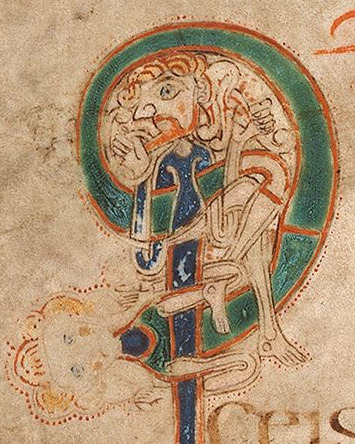

Left to right: Book of Kells folios 130r, 97v, 292r
A couple of sculptures in County Fermanagh might sport depictions of Irish tattoos. The first, known as the Bishop stone, is in the Killadeas cemetery. It features a carved head with 2 marks on the left side of the face, a double line beside the mouth and a single line below the eye. These lines may represent tattoos.
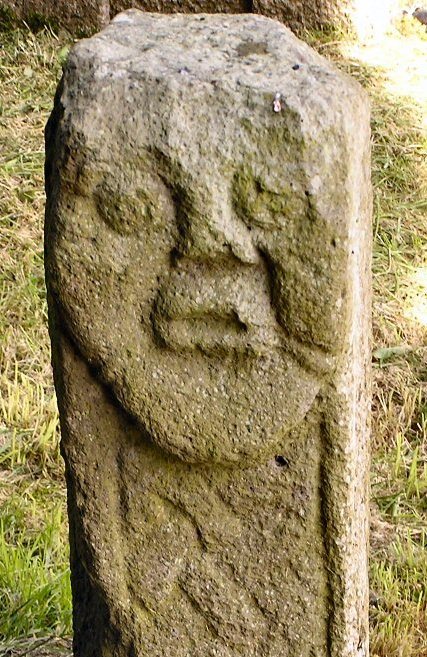
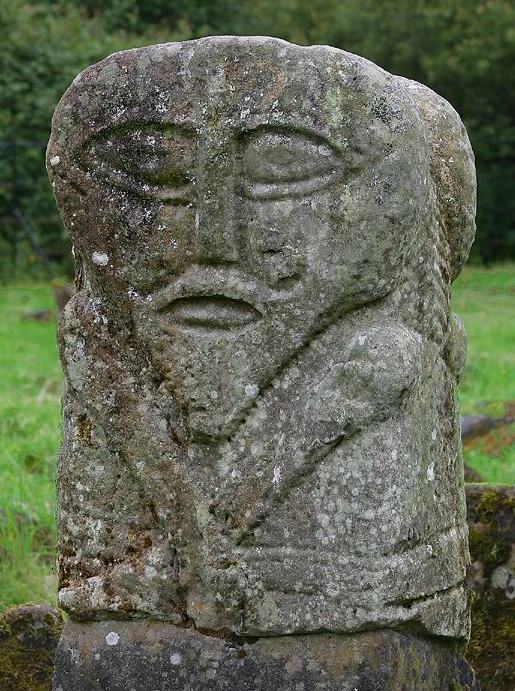
The second sculpture is the Janus figure on Boa Island. (So named because it has 2 faces; it's not Roman.) It has marks under the right eye and extending from the corner of the left eye that may be tattoos.
I cannot find a definitive date for the Bishop stone head, but it bears a strong resemblance to the nearby White Island church figures. The White Island figures are stylistically dated to the 9th-10th centuries and may come from a church that was destroyed by Vikings in 837 CE (Halpin and Newman 2006, Lowry-Corry 1959). The Janus figure is believed to be Iron Age or early medieval (Halpin and Newman 2006).
Conclusions:
Despite the fact that tattooing as a custom in the British Isles lasted for more than 500 years and was practiced by at least 3 different cultures, written sources remain our only solid evidence for it. With only a dozen sources, some of which probably copied each other, to cover this time span, there are huge gaps in our knowledge. The 4th century Picts may not have had the same tattoo designs, placements or reasons for getting tattooed as the 8th c. Irish or Anglo-Saxons. These sources only give us fragments of information on who got tattooed, where the tattoos were placed, what they looked like, how the tattoos were done, and why people got tattooed. Further complicating our limited information is the fact that most of the text sources come from foreigners and/or people who were prejudiced against tattooing, which calls their accuracy into question.
'The Cauldron of Posey' is one source that provides some detail while not showing prejudice against tattoos. The author of the poem was probably Christian, but the poem appears to have been written at a time when Pagan practices were still tolerated in Ireland. I have a complete translation of the poem along with a longer discussion of religious elements here.
Leave me a tip?
Bibliography:
BBC (2024). Bellaghy bog body: Human remains are 2,000 years old https://www.bbc.com/news/uk-northern-ireland-68092307
Breatnach, L. (1981). The Cauldron of Poesy. Ériu, 32(1981), 45-93. https://www.jstor.org/stable/30007454
Carey, J. (1997). The Three Things Required of a Poet. Ériu, 48(1997), 41-58. https://www.jstor.org/stable/30007956
Carr, Gillian. (2005). Woad, Tattooing and Identity in Later Iron Age and Early Roman Britain. Oxford Journal of Archaeology 24(3), 273–292. https://doi.org/10.1111/j.1468-0092.2005.00236.x
Cowie, T., Pickin, J. and Wallace, T. (2011). Bog bodies from Scotland: old finds, new records. Journal of Wetland Archaeology 10(1): 1–45.
Cunliffe, B. (1977) The Romano-British Village at Chalton, Hants. Proceedings of the Hampshire Field Club and Archaeological Society, 33(1977), 45-67.
Dunlevy, Mairead (1989). Dress in Ireland. B. T. Batsford LTD, London.
eDIL s.v. crechad https://dil.ie/12794
Giles, Melanie. (2020). Bog Bodies Face to face with the past. Manchester University Press, Manchester. https://library.oapen.org/viewer/web/viewer.html?file=/bitstream/handle/20.500.12657/46717/9781526150196_fullhl.pdf?sequence=1&isAllowed=y
Halpin, A., Newman, C. (2006). Ireland: An Oxford Archaeological Guide to Sites from Earliest Times to AD 1600. Oxford University Press, Oxford. https://archive.org/details/irelandoxfordarc0000halp/page/n3/mode/2up
Hoecherl, M. (2016). Controlling Colours: Function and Meaning of Colour in the British Iron Age. Archaeopress Publishing LTD, Oxford. https://www.google.com/books/edition/Controlling_Colours/WRteEAAAQBAJ?hl=en&gbpv=0
Lambert, S. K. (2004). The Problem of the Woad. Dunsgathan.net. https://dunsgathan.net/essays/woad.htm
Lowry-Corry, D. (1959). A Newly Discovered Statue at the Church on White Island, County Fermanagh. Ulster Journal of Archaeology, 22(1959), 59-66. https://www.jstor.org/stable/20567530
MacQuarrie, Charles. (1997). Insular Celtic tattooing: History, myth and metaphor. Etudes Celtiques, 33, 159-189. https://doi.org/10.3406/ecelt.1997.2117
McManus, D. (1988). Irish Letter-Names and Their Kennings. Ériu, 39(1988), 127-168. https://www.jstor.org/stable/30024135
Ó Floinn, R. (1995). Recent research into Irish bog bodies. In R. C. Turner and R. G. Scaife (eds) Bog Bodies: New Discoveries and New Perspectives (p. 137–45). British Museum Press, London. ISBN: 9780714123059
Pankova, S. (2013). One More Culture with Ancient Tattoo Tradition in Southern Siberia: Tattoos on a Mummy from the Oglakhty Burial Ground, 3rd-4th century AD. Zurich Studies in Archaeology, 9(2013), 75-86.
Samadelli, M., Melisc, M., Miccolic, M., Vigld, E.E., Zinka, A.R. (2015). Complete mapping of the tattoos of the 5300-year-old Tyrolean Iceman. Journal of Cultural Heritage, 16(2015), 753–758.
Story, Joanna (1995). Charlemagne and Northumbria : the in
fluence of Francia on Northumbrian politics in the later eighth and early ninth centuries. [Doctoral Thesis]. Durham University. http://etheses.dur.ac.uk/1460/
Szacillo, J. (2012). Irish hagiography and its dating: a study of the O'Donohue group of Irish saints' lives. [Doctoral Thesis]. Queen's University Belfast.
Turner, R.C. (1995). Resent Research into British Bog Bodies. In R. C. Turner and R. G. Scaife (eds) Bog Bodies: New Discoveries and New Perspectives (p. 221–34). British Museum Press, London. ISBN: 9780714123059
Ware, C. (2021). A Literary Commentary on Panegyrici Latini VI(7) An Oration Delivered Before the Emperor Constantine in Trier, ca. AD 310. Cambridge University Press, Cambridge. https://www.google.com/books/edition/A_Literary_Commentary_on_Panegyrici_Lati/oEwMEAAAQBAJ?hl=en&gbpv=0
#early medieval#roman era#pict#tattoos#ancient celts#apologies to people who wanted a shorter post#archaeology#art#anecdotes and observations#statutes and laws#irish history#gaelic ireland#medieval ireland#anglo saxon#insular celts#romano british
112 notes
·
View notes
Text










Stunning 💎
#danna paola#latin recording academy#person of the year#gala#seville#gorgeous#woman#black dress#hair#make-up#goals#spanish#singer
4 notes
·
View notes
Text

Henry Miller and Anaïs Nin, Paris Uncredited and Undated Photograph
August 14, 1932
Anais:
Don’t expect me to be sane anymore. Don’t let’s be sensible. It was a marriage at Louveciennes—you can’t dispute it. I came away with pieces of you sticking to me; I am walking about, swimming, in an ocean of blood, your Andalusian blood, distilled and poisonous. Everything I do and say and think relates back to the marriage...
Here I am back and still smouldering with passion, like wine smoking. Not a passion any longer for flesh, but a complete hunger for you, a devouring hunger. I read the paper about suicides and murders and I understand it all thoroughly. I feel murderous, suicidal. I feel somehow that it is a disgrace to do nothing, to just bide one’s time, to take it philosophically, to be sensible. Where has gone the time when men fought, killed, died for a glove, a glance, etc? (A victrola is playing that terrible aria from Madama Butterfly—"Some day he’ll come!“)
I still hear you singing in the kitchen—a sort of inharmonic, monotonous Cuban wail. I know you’re happy in the kitchen and the meal you’re cooking is the best meal we ever ate together. I know you would scald yourself and not complain. I feel the greatest peace and joy sitting in the dining room listening to you rustling about, your dress like the goddess Indra studded with a thousand eyes.
Anais, I only thought I loved you before; it was nothing like this certainty that’s in me now. Was all this so wonderful only because it was brief and stolen? Were we acting for each other, to each other? Was I less I, or more I, and you less or more you? Is it madness to believe that this could go on? When and where would the drab moments begin? I study you so much to discover the possible flaws, the weak points, the danger zones. I don’t find them—not any. That means I am in love, blind, blind. To be blind forever! (Now they’re singing "Heaven and Ocean” from La Gioconda.)
I picture you playing the records over and over—Hugo’s records. “Parlez moi d amour.” The double life, double taste, double joy and misery. How you must be furrowed and ploughed by it. I know all that, but I can’t do anything to prevent it. I wish indeed it were me who had to endure it. I know now your eyes are wide open. Certain things you will never believe anymore, certain gestures you will never repeat, certain sorrows, misgivings, you will never again experience. A kind of white criminal fervor in your tenderness and cruelty. Neither remorse nor vengeance, neither sorrow nor guilt. A living it out, with nothing to save you from the abysm but a high hope, a faith, a joy that you tasted, that you can repeat when you will.
All morning I was at my notes, ferreting through my life records, wondering where to begin, how to make a start, seeing not just another book before me but a life of books. But I don’t begin. The walls are completely bare—I had taken everything down before going to meet you. It is as though I had made ready to leave for good. The spots on the walls stand out—where our heads rested. While it thunders and lightnings I lie on the bed and go through wild dreams. We’re in Seville and then in Fez and then in Capri and then in Havana. We’re journeying constantly, but there is always a machine and books, and your body is always close to me and the look in your eyes never changes. People are saying we will be miserable, we will regret, but we are happy, we are laughing always, we are singing. We are talking Spanish and French and Arabic and Turkish. We are admitted everywhere and they strew our path with flowers.
I say this is a wild dream—but it is this dream I want to realize. Life and literature combined, love the dynamo, you with your chameleon’s soul giving me a thousand loves, being anchored always in no matter what storm, home wherever we are. In the mornings, continuing where we left off. Resurrection after resurrection. You asserting yourself, getting the rich varied life you desire; and the more you assert yourself the more you want me, need me. Your voice getting hoarser, deeper, your eyes blacker, your blood thicker, your body fuller. A voluptuous servility and tyrannical necessity. More cruel now than before—consciously, wilfully cruel. The insatiable delight of experience.
HVM
--
Everyone else seems to have the brakes on… I never feel the brakes. I overflow. And when I feel your excitement about life flaring, next to mine, then it makes me dizzy. - Anaïs Nin to Henry Miller, 1932
69 notes
·
View notes